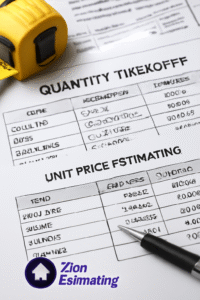Discover 7 essential construction estimating techniques to ensure accurate and efficient project cost management. Learn how to optimize your estimates and improve project outcomes. Construction Estimating Techniques:
Introduction: Why Accurate Construction Estimating Matters
In the fast-paced and competitive world of construction, precise estimating is one of the most crucial aspects of project planning. Accurate construction estimates help contractors, clients, and stakeholders anticipate costs, avoid costly delays, and ensure that a project stays within its budget.
However, estimating can be challenging because of the many variables involved in each project. This article covers seven powerful construction estimating techniques that will help ensure accurate predictions for cost and time, regardless of the project’s scale or complexity. Whether you’re a seasoned contractor or a novice in construction, mastering these techniques will enhance your ability to plan effectively and execute on time.
1. Quantity Takeoff (QTO): The Foundation of Estimating
Quantity Takeoff (QTO) is the process of breaking down construction plans to calculate the materials and resources needed for a project. It’s considered one of the most fundamental estimating techniques because it provides the groundwork for a reliable cost estimate.
The process involves measuring the quantities of raw materials such as cement, steel, timber, and concrete, and converting these quantities into unit prices based on historical data. Using specialized software, estimators can automate the process and increase accuracy. The key to success in quantity takeoff is precision. Mistakes in measurements can cause severe cost overruns.
Benefits of QTO:
-
Provides a detailed list of material requirements
-
Minimizes waste by accurately predicting material needs
-
Forms the basis for all other estimating techniques
2. Unit Price Estimating: Price Per Unit
Unit Price Estimating involves calculating the cost of each unit of work based on historical data and unit prices. The estimator determines the cost of individual work components—like labor, materials, and equipment—and multiplies them by the number of units required for the project.
For example, a contractor may estimate the cost of pouring a cubic meter of concrete, which includes the cost of labor, materials, equipment, and overhead. By multiplying this unit price by the number of cubic meters required, an estimator can arrive at a total cost for the concrete work.
Benefits of Unit Price Estimating:
-
Ideal for repetitive tasks like road construction or site work
-
Allows quick and efficient estimation for projects with similar work elements
-
Provides flexibility to modify estimates as the project scope evolves

Construction Estimating Techniques
3. Analogous Estimating: Using Past Projects for Accurate Forecasting
Analogous Estimating, also known as top-down estimating, uses data from previous projects with similar scopes and conditions to predict the costs of the current project. By comparing historical data, estimators can make quick but reasonably accurate estimates.
This technique is most useful when detailed information is limited and the estimator has a history of similar projects. For example, if a contractor has previously completed several residential buildings, they can use the costs and data from those buildings to estimate costs for a similar structure.
Benefits of Analogous Estimating:
-
Quick and simple to implement
-
Based on real-world data, making it relevant and reliable
-
Best for early-stage project planning or when timelines are tight
4. Parametric Estimating: Leveraging Mathematical Models
Parametric Estimating is a technique where a statistical relationship between historical data and other variables is used to estimate project costs. By using mathematical models or algorithms, estimators predict project costs based on specific parameters like square footage, the number of rooms, or labor hours.
For example, the cost per square foot for building a commercial office space can be calculated based on historical data. Estimators can multiply the cost per square foot by the total square footage to generate an overall cost estimate.
Benefits of Parametric Estimating:
-
High accuracy when reliable data and models are available
-
Reduces the need for detailed, time-consuming takeoffs
-
Works well for projects with established patterns
5. Expert Judgment: The Power of Experience
One of the oldest and most powerful estimating techniques is Expert Judgment. This method relies on the knowledge and experience of skilled professionals—such as senior project managers, engineers, or architects—who have worked on similar projects.
When there is uncertainty or a lack of data, experts use their intuition and experience to provide estimates. This can be a reliable source of information when technical tools or historical data are unavailable. Expert judgment is especially helpful when estimating intangible factors like project risks or unexpected site conditions.
Benefits of Expert Judgment:
-
Valuable when data is incomplete or hard to come by
-
Provides insights from experienced professionals
-
Useful for high-level project assessment
6. Three-Point Estimating: A More Balanced Approach
Three-Point Estimating involves creating three estimates: an optimistic estimate, a pessimistic estimate, and a most likely estimate. These three points are combined to calculate a weighted average that accounts for the inherent uncertainty in construction projects.
The formula typically used is:
Estimated Cost=O+4M+P6\text{Estimated Cost} = \frac{O + 4M + P}{6}
Where:
-
O is the optimistic estimate
-
M is the most likely estimate
-
P is the pessimistic estimate
By incorporating a range of possibilities, this technique helps project managers prepare for various scenarios and allocate contingencies accordingly.
Benefits of Three-Point Estimating:
-
Accounts for uncertainty and risk factors
-
More accurate than relying on a single point estimate
-
Allows for better risk management in project planning
7. Bottom-Up Estimating: Detailed and Comprehensive
Bottom-Up Estimating is a highly detailed approach where the estimator breaks down the project into smaller work components and estimates the costs of each individual component. Once these individual estimates are calculated, they are added together to form the total project cost.
This method is particularly useful for complex projects or those involving a large number of variables. Bottom-Up Estimating requires extensive data and is time-consuming, but it provides the most detailed and reliable estimates.
Benefits of Bottom-Up Estimating:
-
Extremely detailed and accurate
-
Ideal for large or complex projects
-
Provides granular visibility into each component of the project
Conclusion: Choosing the Right Estimating Technique
Selecting the appropriate estimating technique depends on several factors, including the scope and complexity of the project, the available data, and the experience of the estimator. Each of the seven construction estimating techniques described in this article has its strengths and weaknesses.
By understanding the nuances of these techniques, contractors and project managers can make better decisions, reduce costs, and keep projects on schedule. Whether you’re working on a small residential build or a large commercial project, integrating these techniques into your estimating process will enhance your project’s success.
- Construction Estimating Techniques
Contact Information for Zion Estimating:
- Phone Number: 718-427-9941
- Email Address: [email protected]
- Website: https://zionestimating.com
